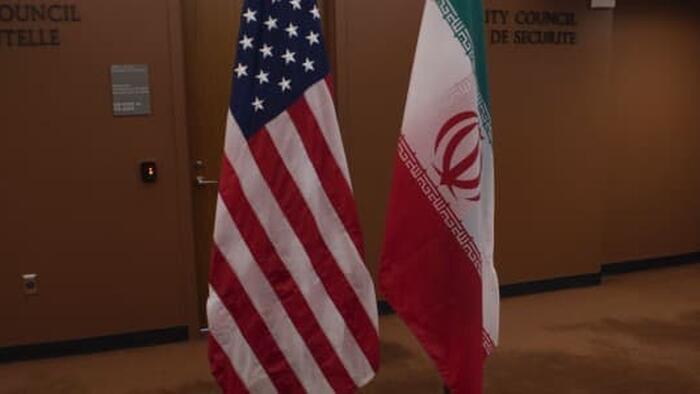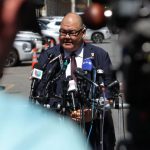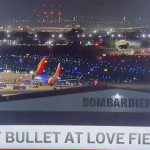Submitted by James Durso,
Donald Trump is back and so is the “maximum pressure” campaign against Iran to “drastically throttle” Iran’s oil sales to kill Tehran’s nuclear program and its ability to fund regional proxies.
But Trump aide Brian Hook who ran the anti-Iran campaign in Trump’s first term claimed Trump has “no interest in regime change.”
That may be true but Iran, and everyone else, probably doesn’t believe it.
The Trump 47 officials may soon learn that 2025 is not 2018 and, while Iran was on the ropes as Trump’s first term ended, things are different now.
To start, open-handed American support for Israel’s campaigns against the Palestinian and Lebanese people has eroded support for U.S. moves by Middle East governments that might normally favor limits on Iran’s behavior.
Saudi Arab’s crown prince, Mohammed bin Salman (MbS), declared Israel was committing “genocide” in Gaza. By using the G-word, MbS has made it hard for his government to walk back his remarks or reverse course absent a cease fire and implementation of something like the Arab Peace Initiative (which has been gathering dust since 2002 and may need a reboot).
MbS also warned Israel against attacking Iran.
Arab-Sunni Saudi Arabia and Persian-Shia Iran have been drawing closer since 2023 they agreed to resume ties after seven years of tensions. That the deal was brokered by China is a sign the regional powers had little confidence in a U.S. role, possibly suspecting it is in Washington’s (and Jerusalem’s) interest to keep the countries of the region divided.
The countries’ military chiefs recently held defense talks, and planned a joint military exercise in the Red Sea (that probably won’t be interrupted by Yemen’s Houthi rebels.) In the civil realm, the countries are moving toward increased economic ties.
The presidents of the United Arab Emirates and Iran held their first face-to-face talks in October, and UAE – Iran trade is on the upswing, and the Saudi crown prince (and de facto ruler) recently spoke to Iran’s new president.
Qatar (which shares a natural gas field with Iran) and Iran are trying to broaden their economic ties that are largely based on hydrocarbons, and Iran supported Qatar during the Saudi-led 2017-2021 attempt to isolate Doha for allegedly supporting terrorism, though criticism of Riyadh by Doha-based Al Jazeera and friendship with Iran are the likely reasons.
After a recent exchange of fire by Israel and Iran, Iran warned its neighbors not to attack Iran or to help the Israelis, and the Gulf Cooperation Council promptly declared, “Our focus has been on de-escalation.” The Gulf states are dubious about “maximum pressure” and are concerned it will upend warming relations with Iran and increase regional tensions.
Middle Eastern governments are sensitive to public anger over American support for Israel’s killing of civilians in Gaza and Lebanon, so will avoid any display of support for a U.S. campaign that may target Arab or Muslim peoples. The countries that signed up for the Abraham Accords may soon look pretty foolish, so when MbS accused Israel of “genocide” in Gaza he was demonstrating Saudi Arabia’s distaste for the U.S. line, unlike the UAE which has increased daily airline flights to Israel.
Also wary of a renewed U.S.-Israeli campaign against Iran and the Central Asian republics. The republics are growing their trade ties to Iran, a market of 90 million people, and the host of seaports at Bandar Abbas and Chabahar, essential for Central Asia trade with Asia and Africa. Iran also hosts the International North-South Transport Corridor (INSTC), a 7,200-kilometer multi-modal transport corridor that connects India to Europe, and is Plan B if a transport route through Afghanistan and Pakistan is not reliable.
Iran has been actively working to strengthen its relations with Central Asian countries as part of its Look East strategy which has seen increased relations with China, Russia, and to offset the effect of Western sanctions. Iran’s Foreign Minister has engaged in discussions with his counterparts in Turkmenistan, Uzbekistan, and the other republics and the newly-elected president of Iran, Masoud Pezeshkian, has met the presidents of Turkmenistan and Kazakhstan.
In Central Asia. Uzbekistan, Kazakhstan, Turkmenistan, and Tajikistan have all increased trade links with Iran, in Tajikistan’s case to include a defense pact. The republics don’t want to sacrifice the opportunity in Iran, a country with a consumer market projected to grow 11% by 2030.
Iran’s focus on Central Asia includes improving trade ties, developing infrastructure projects, and increasing connectivity through transportation networks. For example, Iran has proposed linking the China-Kyrgyzstan-Uzbekistan railway project to its own network, which would provide Central Asian countries with access to the Persian Gulf and beyond.
And the oil market has changed since 2018.
According to Argus Media, Iran’s oil exports, which were below 500,000 b/d through the second half of 2019 and 2020 due to Trump-era sanctions, began increasing in 2021 and have increased every year since: “Exports averaged around 1.6mn b/d in January-October [in 2024].”
If the U.S. again sanctions Iran, it may find it hard going as the remaining buyers may be “those who do not necessarily fear sanctions.” Iran has built out its network to bypass sanctions, and has expanded its tanker fleet, though the clandestine effort is not without substantial costs, such as Chinese customers demanding a substantial discount, and the cost of rebranding the oil to disguise its origin.
Iran has an oil export terminal on the Gulf of Oman, which was inaugurated in July 2021, and can export 1 million barrels per day of oil. The facility cannot replace Iran’s main export terminal at Kharg, which can handle 8 million barrels per day, but it allows Iran to bypass the Strait of Hormuz, a strategic chokepoint and will require the Americans to try to cover two terminals instead of just the main facility at Kharg if Washington decides to attack Iran
The U.S. may try to interdict Iran’s oil exports to China, but what will China’s response be if it considers the interdiction an act of piracy? Beijing may decide to provide a naval escort for the oil shipments or may reflag the vessels as Chinese, upping the ante for the Americans.
If the Peoples’ Liberation Army Navy, the world’s largest navy with newer vessels than the U.S. Navy, deploys to escort the tankers it will refine its “blue water” operating skills. The increased operating tempo will also stress the U.S. fleet which for the second time in a year has no aircraft carrier in the Middle East.
A recent U.S. Navy report noted on the material readiness of Navy ships: “several functional areas and subsystems remained degraded or showed declining trends” since 2017, and the U.S. Government Accountability Office noted in 2021 the Navy needed to improve its limited capacity for battle damage repair, in the event the U.S. and any foe come to blows.
And if the U.S. seizes a China-bound cargo, then what? The ship will have to be anchored somewhere, the cargo will possibly be offloaded and stored, the crew will need to be housed and fed, consular support will need to be provided, and someone will have to guard the vessel. China is the biggest trading partner for every country between the Persian Gulf and the South China Sea, so the U.S. may be unable to find volunteers for these low-return chores.
The U.S. ignored the warning of former national security advisor Zbigniew Brzezinski who said the U.S. should avoid actions that would create “a grand coalition of China, Russia, and perhaps Iran, an ‘antihegemonic’ coalition.” The U.S. has masterfully created that coalition by expanding NATO, ignoring the One China Policy, and sponsoring the 1953 coup in Iran that has freighted the Iranian people with more and more authoritarian rulers.
But the ascension of new presidents in Tehran and Washington may be an opportunity to start rebuilding relations.
After his election in July 2024, President Masoud Pezeshkian announced his program in “My Message to the New World” and declared his intent to strengthen relations with Iran’s neighbors, specifically mentioning Iraq, Türkiye, and the six members of the Gulf Cooperation Council. He emphasized the need for a “strong region,” said he hoped for “constructive dialogue” with Europe, criticized the U.S. for exiting the Joint Comprehensive Plan of Action (JCPOA), and urged Washington “come to terms with reality.”
In October, President-elect Trump declared, “I would like to see Iran be very successful. The only thing is, they can’t have a nuclear weapon.” In 2023, then-Senator JD Vance said that Republican senators who wanted at attack Iran were “living in the past.” In 2024, Republican Vice-President candidate JD Vance said, “And our interest very much is in not going to war with Iran. It would be a huge distraction of resources. It would be massively expensive to our country,”
Those are hopeful signs of a desire to reach a negotiated solution, but can the U.S. abide by any deal once the ink is dry?
Neither Russia, China, nor Iran believe the U.S. will abide by the spirit and letter of any agreement as it has a record of bailing out of any commitments when it is convenient, to wit,
- Anti-Ballistic Missile Treaty
- NATO expansion (“not one inch eastward”)
- Intermediate-Range Nuclear Forces Treaty
- Paris Agreement (Paris Climate Accord)
- Joint Comprehensive Plan of Action
- Minsk agreements
- Open Skies Treaty
- Algiers Accord
- One China Policy
U.S. intervention in Iran started with the 1953 coup. The U.S. then supported Iraq during 1980-1988 war after the U.S. and Iran agreed on the Algiers Accords (January 1981) where the U.S. pledged, “it is and from now on will be the policy of the United States not to intervene, directly or indirectly, politically or militarily, in Iran’s internal affairs,” but this did not stop the U.S. from backing Iraq when the war starting to go in Iran’s favor in 1982.
The U.S. killed General Qasem Soleimani in Iraq when he was carrying a message to Saudi Arabia in an effort to defuse tensions between Tehran and Riyadh. Many Iranians and Saudis probably think Soleimani was killed because he was working to reduce tensions in the region, which they think only benefits the U.S. and Israel. Then there is the killing of civilian Iranian scientists involved in nuclear power research. No one has taken the credit, but the Iranians no doubt believe it was the Americans or the Israelis with American connivance.
Last is the STUXNET virus, a joint U.S.-Israel effort to attack break Iranian nuclear centrifuge equipment which “leaked” and infected computers worldwide.
The Chair of the NATO Military Committee recently admitted the only reason NATO troops are not is Ukraine fighting Russian troops is because Russia has nuclear weapons, which no doubt confirmed the views of Iranians who think the country should have nuclear weapons. Then there is the cautionary tale of Libya’s surrender of its nuclear program, and the mystery of why North Korea, one of the poorest and most isolated countries in the world, has not been attacked by the U.S.
Iran’s relations with Russia and China have strengthened which adds to the country’s resilience.
China and Iran signed a 25-year Comprehensive Strategic Partnership agreement in March 2021. This agreement aims to enhance bilateral relations and includes significant investments from China in Iran’s economy.
China plans to invest $400 billion in Iran’s oil, gas, petrochemicals, transportation, and manufacturing sectors. In return, China will receive a steady and heavily-discounted supply of Iranian oil. The agreement allows China to deploy security personnel to protect its projects in Iran.
The investments will also go towards upgrading Iran’s infrastructure, and the agreement supports China’s One Belt One Road Initiative, by enhancing connectivity and trade routes.
Russia has supplied Iran with Su-35 fighter jets, Mi-28 attack helicopters, Yak-130 pilot training aircraft; Iran has sent Russia drones, and ballistic missiles.
Non-military trade is also increasing. The Moscow Times reports, “Russian exports to Iran rose 27% last year, and Russian imports from Iran increased 10%. Both sides have agreed to scale up trade in currencies other than the U.S. dollar, while Russia has pledged to invest an unprecedented $40 billion in Iran’s oil and gas sector.”
The Times also notes, “Perhaps the most important changes, however, have been in transport networks. As a result of the fighting in Ukraine, and in a bid to bypass Western sanctions, Russia has begun shifting trade routes southward. This is why Iran and Russia have ramped up work to develop the much-touted and ambitious International North-South Transport Corridor (INSTC), which will stretch from the Persian Gulf to the Baltic Sea.”
Despite its economic problems, Iran has increased its military budget, no doubt anticipating attacks by America or Israel. At the same time Iran has signaled it is willing to negotiate with the International Atomic Energy Agency (IAEA), but not “under pressure.” Iran’s foreign minister Abbas Araqchi clarified that when he told state television, “”There is still an opportunity for diplomacy, although this opportunity is not much. It is a limited opportunity.”
A recent IAEA report notes Iran has begun implementing measures “aimed at stopping the increase of its stockpile [of near bomb-grade uranium]” though the IAEA also noted that Iran increased its inventory of 60% enriched uranium by 60% since the last report in August 2024.
Iran’s President Pezeshkian has indicated he is open to U.S. engagement: “”Whether we like it or not, we will face the United States in regional and international arenas, and it’s better that we manage this arena ourselves.” And opinion leaders in Iran are saying their government should engage with Trump, with Shargh, the reformist daily newspaper editorializing that President Pezeshkian, must “avoid past mistakes and assume a pragmatic and multidimensional policy,” though others are skeptical anything will change under Trump.
Even the Quds Force commander, General Qassem Soleimani, once mused: “maybe it’s time to rethink our relationship with the Americans,” though in the end it didn’t do him much good.
All that said, “maximum pressure” is a slogan, not a strategy. If Iran says “Yes,” will Washington finally produce a coherent, executable strategy for its future dealings with Iran? Up to now its only strategy has been “more sanctions,” hoping some liberals will miraculously appear and (democratically) seize power when in fact the Revolutionary Guard may take over and finally dispense with Vilayat-e Faqih.
Whatever strategy Washington produces will be overshadowed by the disastrous retreat from Afghanistan in 2021, so the U.S. should favor a policy that increases regional connectivity and economic growth rather than carrying water for Israel or satisfying its desire to avenge the humiliation of 1979.
Iran won’t surrender its hard-won nuclear expertise and has increased cooperation with the IAEA, but will it ever dash to the bomb? Israel claims it destroyed key Iranian nuclear fabrication facilities but the head of the IAEA said of the attack, “as far as the IAEA is concerned, we do not see this as a nuclear facility.” Trump will not want to start a war with Iran over its nuclear program as he will be sensitive to the impact on the U.S. economy, so sanctions (and the occasional Israeli attack) will be all he has left. If that is the case, and Iran’s economy and oil export scheme is resilient enough, and Russia and China remain constant, we may be looking at years of low-level “endless wars” to the joy of the Iran hawks in Washington.
And there is a deadline of sorts for negotiations with Iran: 18 October 2025 sees the end of the JCPOA snapback mechanism, the last opportunity for world powers to initiate the snapback mechanism, returning all the sanctions that were lifted in the JCPOA agreement…”
If the U.S. rejoins any sort of nuclear deal, it will have to be a new deal as Iran blew past the JCPOA 1.0 conditions after the U.S. abandoned the agreement. If the Americans want to expand a 2.0 deal to include ballistic missiles or Iran’s foreign policy, Iran may suggest similar limits on other countries in the region, and then demand that 2.0 be a treaty to bound future U.S. action, and to exploit differences in the U.S. on what is a “good deal” that will be all too evident once the Senate takes up the treaty for ratification.
So far, each side has demonstrated a lack of empathy for the other, the result of years of successful propagandizing, leaving each feeling more sinned against than sinning. And the hard-liners in each capital believe in the other’s perfidy, see conflict as key to their continued influence, and reap economic rewards from the status quo.
On the U.S. side, Washington has never explained to American citizens its role in the 1953 coup that stifled Iran’s economic and political development, though Secretary of State Madeleine Albright admitted the U.S. role in overthrowing Prime Minister Mohammad Mossadegh in 1953 and called the coup “a setback for Iran’s political development.” To many Americans, the 1979 revolution and the hostage crisis appeared out of thin air.
The U.S. needs to think long-term. Iran’s mullahs won’t rule forever and Americas association with economic hardship and violence won’t benefit it in the future. The U.S. should adopt a parallel effort to President Pezeshkian’s “strong region” plan to emphasize trade and connectivity which will help the region make up the gains sacrificed in the “lost decades” of the U.S. occupation of Afghanistan.
Despite all the talk about what Trump might do, Biden is still the U.S. president until 11:59 on 20 January 2025.
If both sides stick to what is feasible, keep their emotions and hard-liners in check, and Iran offers Trump a deal that he feels only he could have made, we may see stability and more economic opportunity for the region’s youth and the start of the banishment of the legacies of 1953 and 1979
Loading…











